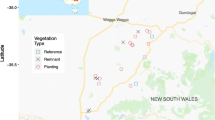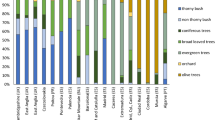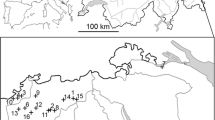Abstract
Context
The conversion of agricultural landscapes to tree plantations is a major form of landscape transformation worldwide, but its effects on biodiversity, particularly key population processes like reproductive success, are poorly understood.
Objectives
We compared bird breeding success between woodland remnants surrounded by maturing stands of plantation Radiata Pine and a matched set of woodland remnants in semi-cleared grazing land.
Methods
Our study was conducted in the Nanangroe region in south-eastern New South Wales, Australia. Using repeated field measurements, we quantified bird breeding success in 23 woodland remnants; 13 surrounded by Radiata Pine plantations and 10 on farms where remnants were surrounded by semi-cleared grazing land. We matched the attributes of native remnant patches between two types of matrix.
Results
We found that: (1) rates of nesting success of smaller-bodied birds in woodland remnants surrounded by grazing land were significantly higher than in woodland remnants surrounded by pine plantations; and (2) taxa with domed nests were more successful at nesting than species that constructed open cup/bowl nests in woodland remnants within farmlands.
Conclusions
Our findings suggest that bird breeding success in remnant woodland patches is significantly diminished as a result of the conversion of semi-cleared grazing land to pine plantations.


Similar content being viewed by others
References
Beruldsen GR (2003) Australian birds: their nests and eggs. G & E Beruldsen, Kenmore Hills
Best LB, Stauffer F (1980) Factors affecting nesting success in riparian bird communities. The Condor 82:149
Bobo KS, Waltert M, Fermon H, Njokagbor J, Mühlenberg M (2006) From forest to farmland: butterfly diversity and habitat associations along a gradient of forest conversion in southwestern Cameroon. J Insect Conserv 10:29–42
Bureau of Meteorology (2015) Twelve-monthly rainfall totals for New South Wales/ACT. http://www.bom.gov.au/jsp/awap/rain/index.jsp?colour=colour&time=latest&step=0&map=totals&period=12month&area=ns. Australian Government
Chalfoun AD, Martin TE (2010) Facultative nest patch shifts in response to nest predation risk in the Brewer’s sparrow: a “win-stay, lose-switch” strategy? Oecologia 163:885–892
Chambers LK, Dickman CR (2002) Habitat selection of the long-nosed bandicoot, Perameles nasuta (Mammalia, Peramelidae), in a patchy urban environment. Austral Ecol 27:334–342
Collias NE (1997) On the origin and evolution of nest building by passerine birds. The Condor 99:253–270
Colombelli-Négrel D, Kleindorfer S (2009) Nest height, nest concealment, and predator type predict nest predation in superb fairy-wrens (Malurus cyaneus). Ecol Res 24:921–928
Cruz-McDonnell KK, Wolf BO (2016) Rapid warming and drought negatively impact population size and reproductive dynamics of an avian predator in the arid southwest. Glob Change Biol 22:237–253
Davidai N, Westbrook JK, Lessard J-P, Hallam TG, McCracken GF (2015) The importance of natural habitats to Brazilian free-tailed bats in intensive agricultural landscapes in the Winter Garden region of Texas, United States. Biol Conserv 190:107–114
DeGregorio BA, Weatherhead PJ, Sperry JH (2014) Power lines, roads, and avian nest survival: Effects on predator identity and predation intensity. Ecol Evol 4:1589–1600
Department of the Environment (2016) Weeds of National Significance. http://www.environment.gov.au/biodiversity/invasive/weeds/weeds/lists/wons.html. Department of the Environment, Canberra
Donovan TM, Jones PW, Annand EM, Thompson FR (1997) Variation in local-scale edge effects: mechanisms and landscape context. Ecology 78:2064
Dornelas M, Gotelli NJ, McGill B, Magurran AE (2014) Overlooked local biodiversity loss: response. Science 344:1098–1099
Driscoll DA, Banks SC, Barton PS, Lindenmayer DB, Smith AL (2013) Conceptual domain of the matrix in fragmented landscapes. Trends Ecol Evol 28:605–613
Dukas R (2013) Effects of learning on evolution: robustness, innovation and speciation. Anim Behav 85:1023–1030
DuRant SE, Hopkins WA, Hepp GR, Walters JR (2013) Ecological, evolutionary, and conservation implications of incubation temperature-dependent phenotypes in birds. Biol Rev 88:499–509
FAO (2010) Global Forest Resources Assessment 2010: main report. Food and Agriculture Organisation, Rome
Felton A, Knight E, Wood J, Zammit C, Lindenmayer D (2010) A meta-analysis of fauna and flora species richness and abundance in plantations and pasture lands. Biol Conserv 143:545–554
Ford HA (1999) Nest site selection and breeding success in large Australian honeyeaters: are there benefits from being different? Emu 99:91–99
Gardner JL (1998) Experimental evidence for edge-related predation in a fragmented agricultural landscape. Aust J Ecol 23:311–321
Gill DE (1985) Interpreting breeding patterns from census data: A solution to the husting dilemma. Ecology 66:344–354
Guida-Johnson B, Zuleta GA (2013) Land-use land-cover change and ecosystem loss in the Espinal ecoregion, Argentina. Agric Ecosyst Environ 181:31–40
Harper KA, Macdonald SE, Burton PJ, Chen JQ, Brosofske KD, Saunders SC, Euskirchen ES, Roberts D, Jaiteh MS, Esseen PA (2005) Edge influence on forest structure and composition in fragmented landscapes. Conserv Biol 19:768–782
Hepp GR, Kennamer RA (2012) Warm is better: Incubation temperature influences apparent survival and recruitment of wood ducks (Aix sponsa). PLoS ONE 7:e47777
Hinsley SA, Rothery P, Bellamy PE (1999) Influence of woodland area on breeding success in great tits Parus major and blue tits Parus caeruleus. J Avian Biol 30:271–281
Howell CA, Dijak WD, Thompson FR (2007) Landscape context and selection for forest edge by breeding Brown-headed Cowbirds. Landscape Ecol 22:273–284
Hulvey KB, Hobbs RJ, Standish RJ, Lindenmayer DB, Lach L, Perring MP (2013) Benefits of tree mixes in carbon plantings. Nat Clim Change 3:869–874
Jenkins SR, Betts MG, Huso MM, Hagar JC (2013) Habitat selection by juvenile Swainson’s thrushes (Catharus ustulatus) in headwater riparian areas, Northwestern Oregon, USA. Forest Ecol Manag 305:88–95
Knutson MG, Niemi GJ, Newton WE, Friberg MA (2004) Avian nest success in midwestern forests fragmented by agriculture. The Condor 106:116–130
Lahti DC (2001) The “edge effect on nest predation” hypothesis after twenty years. Biol Conserv 99:365–374
Lampert A, Hastings A, Grosholz ED, Jardine SL, Sanchirico JN (2014) Optimal approaches for balancing invasive species eradication and endangered species management. Science 344:1028–1031
Lindenmayer DB (2009) Large-scale landscape experiments. Lessons from Tumut. Cambridge University Press, Cambridge
Lindenmayer DB, Fischer J (2006) Habitat fragmentation and landscape change. Island Press, Washington
Lindenmayer DB, Cunningham RB, MacGregor C, Tribolet C, Donnelly CF (2001) A prospective longitudinal study of landscape matrix effects on fauna in woodland remnants: experimental design and baseline data. Biol Conserv 101:157–169
Lindenmayer DB, Cunningham RB, MacGregor C, Crane M, Michael D, Fischer J, Montague-Drake R, Felton A, Manning A (2008) Temporal changes in vertebrates during landscape transformation: a large-scale “natural experiment”. Ecol Monogr 78:567–590
Lindenmayer DB, Wood JT, Cunningham RB, Crane M, Macgregor C, Michael D, Montague-Drake R (2009) Experimental evidence of the effects of a changed matrix on conserving biodiversity within patches of native forest in an industrial plantation landscape. Landscape Ecol 24:1091–1103
Lindenmayer D, Blanchard W, Tennant P, Barton P, Ikin K, Mortelliti A, Okada S, Crane M, Michael D (2015a) Richness is not all: how changes in avian functional diversity reflect major landscape modification caused by pine plantations. Divers Distrib 21:836–847
Lindenmayer D, Messier C, Paquette A, Hobbs RJ (2015b) Managing tree plantations as novel socioecological systems: Australian and North American perspectives. Can J Forest Res 45:1427–1433
Lloyd P, Martin TE, Redmond RL, Langner U, Hart MM (2005) Linking demographic effects of habitat fragmentation across landscapes to continental source-sink dynamics. Ecol Appl 15:1504–1514
Mackenzie JA, Hinsley SA, Harrison NM (2014) Parid foraging choices in urban habitat and their consequences for fitness. Ibis 156:591–605
Manning AD, Lindenmayer DB, Barry SC (2004) The conservation implications of bird reproduction in the agricultural “matrix”: a case study of the vulnerable superb parrot of south-eastern Australia. Biol Conserv 120:363–374
Massaro M, Stanbury M, Briskie JV (2013) Nest site selection by the endangered black robin increases vulnerability to predation by an invasive bird. Anim Conserv 16:404–411
Mortelliti A, Lindenmayer DB (2015) Effects of landscape transformation on bird colonization and extinction patterns in a large-scale, long-term natural experiment. Conserv Biol 29:1314–1326
Mortelliti A, Crane M, Okada S, Lindenmayer DB (2015a) Marsupial response to matrix conversion: results of a large-scale long-term ‘natural experiment’ in Australia. Biol Conserv 191:60–66
Mortelliti A, Michael DR, Lindenmayer DB (2015b) Contrasting effects of pine plantations on two skinks: results from a large-scale ‘natural experiment’ in Australia. Anim Conserv 18:433–441
Mortelliti A, Westgate MJ, Lindenmayer DB (2014) Experimental evaluation shows limited influence of pine plantations on the connectivity of highly fragmented bird populations. J Appl Ecol 51:1179–1187
Newmark WD, Stanley TR (2011) Habitat fragmentation reduces nest survival in an Afrotropical bird community in a biodiversity hotspot. Proc Natl Acad Sci USA 108:11488–11493
Noske RA, Fischer S, Brook BW (2008) Artificial nest predation rates vary among habitats in the Australian monsoon tropics. Ecol Res 23:519–527
Paquette A, Messier C (2010) The role of plantations in managing the world’s forests in the Anthropocene. Front Ecol Environ 8:27–34
Rastogi DA, Zanette L, Clinchy M (2006) Food availability affects diurnal nest predation and adult antipredator behaviour in song sparrows, Melospiza melodia. Anim Behav 72:933–940
Remeš V, Matysioková B, Cockburn A (2012) Long-term and large-scale analyses of nest predation patterns in Australian songbirds and a global comparison of nest predation rates. J Avian Biol 43:435–444
Sweaney N, Driscoll DA, Lindenmayer DB, Porch N (2015) Plantations, not farmlands, cause biotic homogenisation of ground-active beetles in south-eastern Australia. Biol Conserv 186:1–11
Waltert M, Mardiastuti ANI, Mühlenberg M (2004) Effects of land use on bird species richness in Sulawesi, Indonesia. Conserv Biol 18:1339–1346
Watson SJ, Luck GW, Spooner PG, Watson DM (2014) Land-use change: incorporating the frequency, sequence, time span, and magnitude of changes into ecological research. Front Ecol Environ 12:241–249
Wilson JD, Anderson R, Bailey S, Chetcuti J, Cowie NR, Hancock MH, Quine CP, Russell N, Stephen L, Thompson DBA (2014) Modelling edge effects of mature forest plantations on peatland waders informs landscape-scale conservation. J Appl Ecol 51:204–213
With KA, Schrott GR, King AW (2006) The implications of meta landscape connectivity for population viability in migratory songbirds. Landscape Ecol 21:157–167
Zanette L, Doyle P, Tremont SM (2000) Food shortage in small fragments: evidence from an area-sensitive passerine. Ecology 81:1654–1666
Acknowledgements
We thank Andrew Keating for access to his farms. We thank Damian Michael for his comments that improved earlier versions of the manuscript. Field work was approved by Animal Ethics Committee of The Australian National University (Approved Number: A2012/46) and also conducted under a NPWS Scientific Research Licence (SL100982).
Author information
Authors and Affiliations
Corresponding author
Electronic supplementary material
Below is the link to the electronic supplementary material.
Rights and permissions
About this article
Cite this article
Okada, S., Lindenmayer, D.B., Wood, J.T. et al. How does a transforming landscape influence bird breeding success?. Landscape Ecol 32, 1039–1048 (2017). https://doi.org/10.1007/s10980-017-0507-x
Received:
Accepted:
Published:
Issue Date:
DOI: https://doi.org/10.1007/s10980-017-0507-x




